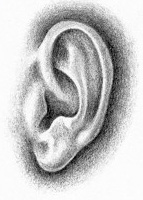Excerpts from AME Guide |
 |
Guide for Aviation Medical Examiners
Application Process for Medical Certification
Exam Techniques and Criteria for Qualification
Item 49. Hearing
- Code of Federal Regulations
- First-Class: 14 CFR 67.105(a)(b)(c)
- Second-Class: 14 CFR 67.205(a)(b)(c)
- Third-Class: 14 CFR 67.305(a)(b)(c)
- FAA Approved Examination Techniques Used by FAA Designated AMEs
III. Aerospace Medical Dispositions
Item 49. Hearing - Auditory Standards
| 500 Hz | 1,000 Hz | 2,000 Hz | 3,000 Hz | |
|---|---|---|---|---|
| Better Ear | 35 dB | 30 dB | 30 dB | 40 dB |
| Worst Ear | 35 dB | 50 dB | 50 dB | 60 dB |
- Special Issuance of Medical Certificates. Applicants who do not meet the auditory standards may be found eligible for a SODA. An applicant seeking a SODA must make the request in writing to the Aerospace Medicine Certification Division, AAM-300. A determination of qualifications will be made on the basis of a special medical examination by an ENT consultant (otolaryngologist), a MFT, or operational experience.
- Bilateral Deafness. If otherwise qualified, the AMCD may issue a combination medical/student pilot certificate with the limitation
VALID FOR STUDENT PILOT PURPOSES ONLY
as well as the limitation
NOT VALID FOR CONTROL ZONES OR AREAS WHERE RADIO COMMUNICATION IS REQUIRED.
This will enable the applicant to proceed with training to the point of a private pilot checkride. See Items 25-30.
When the student pilot's instructor confirms the student's eligibility for a private pilot checkride, the applicant should submit a written request to the AMCD, for an authorization for a MFT. This test will be given by an FAA inspector in conjunction with the checkride. If the applicant successfully completes the test, the FAA will issue a third-class medical certificate and SODA. Pilot activities will be restricted to areas in which radio communication is not required. - Hearing Aids. If the applicant meets the standard with the use of hearing aids, the certificate may be issued with the following restriction:
VALID ONLY WITH USE OF HEARING AMPLIFICATION
Some pilots who normally wear hearing aids to assist in communicating while on the ground report that they elect not to wear them while flying. They prefer to use the volume amplification of the radio headphone. Some use the headphone on one ear for radio communication and the hearing aid in the other for cockpit communications.
Important: Review the Section on How the Hearing Exam is Conducted.
Note: Numbers correspond to the required entry in the AME portion of the FAA Form 8500-8
Note: Numbers correspond to the required entry in the AME portion of the FAA Form 8500-8
